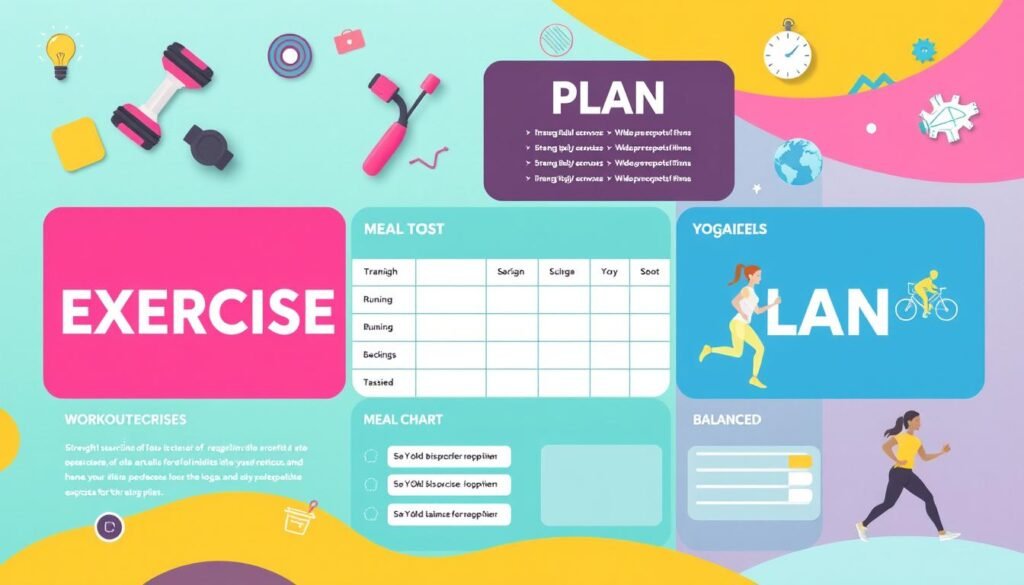Stepping on the scale can feel daunting, when the numbers don’t change. But, losing weight is possible with the right lifestyle changes. I’ve struggled with weight myself, finding the right diet and exercise balance hard. Yet, with a few simple strategies, you can reach your goals.
Key Takeaways
- Aim for at least 150 minutes of moderate physical activity or 75 minutes of vigorous aerobic activity per week
- Focus on creating a calorie deficit through a combination of diet and exercise
- Successful weight loss involves making lasting lifestyle changes, including eating a balanced diet and increasing daily physical activity
- Cleaning the house, making the bed, shopping, mowing, and gardening are all forms of physical activity
- Taking a brisk walk is an example of moderate activity
Understanding the Fundamentals of Weight Loss Science
Weight loss isn’t just about counting calories or following trends. It’s about understanding the science behind it. Let’s dive into the key principles for weight loss and how to use them to achieve your health goals.
Caloric Deficit and Energy Balance
The core of weight loss is creating a caloric deficit. This means eating fewer calories than your body uses, leading to weight loss. By tracking calories and staying active, you can keep this deficit and lose weight.
Role of Metabolism in Weight Loss
Your metabolism is key to managing weight. It’s how your body turns food into energy. Age, gender, muscle, and hormones affect your metabolism. Boosting your metabolism through exercise and building muscle can help with weight loss.
Body Mass Index and Weight Management
Body Mass Index (BMI) helps gauge your weight status. It’s not perfect but useful. Staying within a healthy BMI range can help manage weight and lower health risks. But, remember, BMI doesn’t tell the whole story.
By grasping these weight loss science basics, you can craft a solid weight management plan. Combining calorie control, metabolism boosters, and BMI awareness leads to lasting, healthy weight loss.
“The key to successful weight loss is not just about restricting calories, but understanding the complex interplay between your body, metabolism, and the science of energy balance.”
Creating a Sustainable Meal Plan for Weight Loss
Starting a sustainable weight loss journey begins with a balanced meal plan. Include a variety of nutrient-dense foods in your diet. Aim for 25-30 grams of fiber daily to stay full and support digestion.
Make sure each meal has fruits, vegetables, whole grains, and lean proteins. Avoid trans fats and limit saturated fats. Choose healthy fats from avocados, nuts, and olive oil. Focus on nutrient-rich foods and avoid processed items with added sugars and unhealthy fats. This will help you achieve a balanced diet for weight loss.
Planning meals in advance is key for a healthy meal plan. Spend time each week planning meals, making a grocery list, and getting the right ingredients. This keeps you on track with your nutritional goals and makes meal prep easier and less stressful.
| Meal | Nutrient-Dense Food Options |
|---|---|
| Breakfast | Oatmeal, eggs, Greek yogurt, berries, whole-grain toast |
| Lunch | Salads with mixed greens, grilled chicken, avocado, nuts |
| Snacks | Fruit, raw vegetables, hummus, unsalted nuts, hard-boiled eggs |
| Dinner | Grilled salmon, roasted vegetables, quinoa, lentil soup |
By sticking to a sustainable meal plan with nutrient-dense foods, portion control, and balanced nutrition, you can reach your weight loss goals. This approach supports a healthy lifestyle for the long term.
Diet and Exercise Tips for Weight Loss: A Complete Guide
For lasting weight loss, you need a mix of healthy eating and regular exercise. This guide will help you find the right balance. It’s all about managing your weight and feeling better overall.
Essential Nutrition Principles
Nutrition is key for weight loss. Eat a variety of foods, control your portions, and drink plenty of water. Include lean proteins, complex carbs, and healthy fats in your diet. Stay away from junk food and sugary drinks. Choose whole foods for their vitamins, minerals, and fiber.
Effective Exercise Strategies
Exercise is vital for losing weight. Mix cardio and strength training for best results. Aim for 30 minutes of moderate exercise daily, like walking or cycling. Choose workouts that challenge you and keep your heart rate up.
Combining Diet and Movement
For the best weight loss, balance your diet and exercise. Make small changes to move more each day. Use stairs, park far, and walk more. A healthy diet and regular exercise lead to lasting weight loss and better health.
| Nutrition Tips | Exercise Strategies |
|---|---|
|
|
By following these tips, you’ll be on your way to reaching your weight loss goals. Enjoy a healthy, balanced lifestyle for the long term.
“Sustainable weight loss is not about quick fixes, but about adopting healthy, long-term habits that become a natural part of your lifestyle.”
Building Healthy Eating Habits
Creating healthy eating habits is key to lasting weight loss. By practicing mindful eating, you can enjoy food more. Take your time, appreciate the flavors, and focus on the moment.
Keeping a food diary helps too. It lets you see patterns and make better food choices.
Meal planning is also important. Plan your meals and snacks ahead. This way, you won’t grab unhealthy food when you’re hungry.
Make sure your kitchen has healthy foods. Cook meals early so you always have a good choice. Avoid liquid calories from sweet drinks and drink water or unsweetened drinks instead.
| Healthy Eating Habit | Benefit |
|---|---|
| Mindful Eating | Enhances enjoyment and satisfaction from food, promotes better awareness of hunger and fullness cues. |
| Meal Planning | Reduces impulsive, unhealthy choices, ensures a steady supply of nutritious options. |
| Drinking Water | Helps to stay hydrated, can reduce calorie intake by replacing sugary beverages. |
By adding these habits to your life, you’ll reach your weight loss goals. You’ll also keep eating well for a long time.

“The key to successful weight loss is to adopt sustainable habits, not quick fixes.”
Smart Portion Control Strategies
Weight loss is more than just cutting calories. It’s about managing your portion sizes well. Knowing serving sizes and using practical measuring methods helps control calorie intake. This sets you up for long-term weight management success.
Understanding Serving Sizes
Learning about standard serving sizes is key to portion control. Use everyday objects as visual cues. A clenched fist is about 1 cup, a tennis ball is 1/2 cup, and a deck of cards is 3 ounces of meat. These references help you gauge the right food amount on your plate.
Practical Measuring Methods
Using measuring tools is a big help for portion control. Get a reliable set of measuring cups and spoons. When eating out, choose smaller plates to control portions. Also, consider sharing a meal or taking leftovers home.
Mindful Eating Techniques
Mindful eating is vital for portion control. Eat slowly, enjoy each bite, and listen to your hunger and fullness signals. Avoid distractions like TV or phones while eating. This way, you’ll stop eating when you’re just satisfied, not too full.
Adopting these smart portion control strategies can help you reach your weight loss goals. Remember, it’s not about cutting out food but finding the right balance. This nourishes your body and supports your well-being.
Designing Your Effective Workout Routine
1. Incorporate Cardio and Strength Training
To achieve fitness goals, it’s important to have a balanced workout routine. Aim for at least 150 minutes of moderate-intensity cardio each week, such as walking, jogging, cycling, or swimming. Pairing this with strength training exercises twice a week helps build muscle and boosts metabolism.
2. Focus on Full-Body Workouts
For effective weight loss, a routine should combine full-body strength exercises, cardio, and muscle-building movements. Strength training helps burn fat by keeping your metabolism elevated for up to 24 hours post-workout.
3. Start Slow and Progress Gradually
To avoid injury and build endurance, start with lower intensity workouts and gradually increase the intensity over time. Rest days are essential for recovery, so always listen to your body and adjust your routine accordingly.
4. Choose Enjoyable Activities
Staying motivated is easier when you enjoy your workouts. Find activities that are fun and engaging. Aim for at least 10,000 steps a day and include at least 30 minutes of heart-pumping exercises like running or cycling.
5. Stay Hydrated
Hydration is key for weight loss and performance. Drinking four to six cups of water daily helps to keep your body fueled and supports optimal workout performance.
By designing a well-rounded workout routine, combining cardio, strength training, and activities you enjoy, you’ll effectively work toward your fitness goals while maintaining a balanced and healthy lifestyle.
“Starting a long-term exercise program is key to success in physical activity.” – American Heart Association

Consistency and balance are key to a good workout routine. Start slow, listen to your body, and gradually increase your workouts. With the right plan and dedication, you can reach your weight loss and fitness goals.
Cardio Exercises for Maximum Fat Burning
Adding the right cardio exercises to your routine can change the game for weight loss. You can choose from high-intensity interval training (HIIT) to steady-state cardio. Each option helps burn fat and boost your heart health.
High-Intensity Interval Training Benefits
HIIT workouts are famous for increasing your metabolism and burning calories fast. They mix intense activity with rest periods. This combo is great for losing fat and getting fitter. Try sprinting, cycling, or rowing for the best results.
Steady-State Cardio Options
Steady-state cardio, like brisk walking or jogging, is also effective. It burns fat and improves heart health. These activities might not be as intense as HIIT, but they help create a calorie deficit.
Building Cardiovascular Endurance
To get better at cardio, start with short, easy workouts and gradually increase the time and intensity. Mix different cardio activities, like running or swimming, to keep your body challenged and avoid plateaus.
For lasting weight loss, combine a healthy diet with a balanced workout routine. Include various cardio exercises and strength training to reach your fitness goals.
| Exercise | Calories Burned (30 minutes) |
|---|---|
| HIIT Workout | 200-400 calories |
| Brisk Walking | 140-295 calories |
| Jogging | 240-400 calories |
| Cycling | 200-400 calories |
| Swimming | 180-360 calories |
“A combination of HIIT workouts and steady-state cardio can help you achieve maximum fat-burning results and improve your overall cardiovascular fitness.”
Strength Training for Weight Management
Adding strength training to your workout routine can really help with weight management. It helps build muscle, which boosts your metabolism. This means your body burns more calories, even when you’re not moving.
Make sure to do exercises that work all your big muscle groups. Squats, deadlifts, push-ups, planks, rows, and pull-ups are good choices.
Experts say you should do strength training at least two times a week. You might need to do it three times as you get stronger. Start with four sets of 8-12 reps for each exercise. Take 60-120 seconds to rest between sets.
As you get stronger, add more weight and intensity. This keeps your muscles challenged and helps them grow.
Strength training does more than just help with weight loss. It also gives you more energy, better flexibility, and less chance of getting hurt. It’s good for your heart and mind too. Pair it with a healthy diet, and you’ll reach your weight goals and live a healthier, more active life.





Howdy! Someone in my Facebook group shared this site with us so I came to give it a look. I’m definitely loving the information. I’m book-marking and will be tweeting this to my followers! Fantastic blog and great design and style.
I’m delighted that you found the information cool and useful. I’ll make sure to keep you updated with more valuable insights. Thank you for your kind words and for appreciating the shared information. Your support means a lot!
It’s really a cool and useful piece of info. I’m glad that you shared this useful info with us. Please keep us informed like this. Thanks for sharing.
I really thankful to find this website on bing, just what I was looking for : D also saved to my bookmarks.